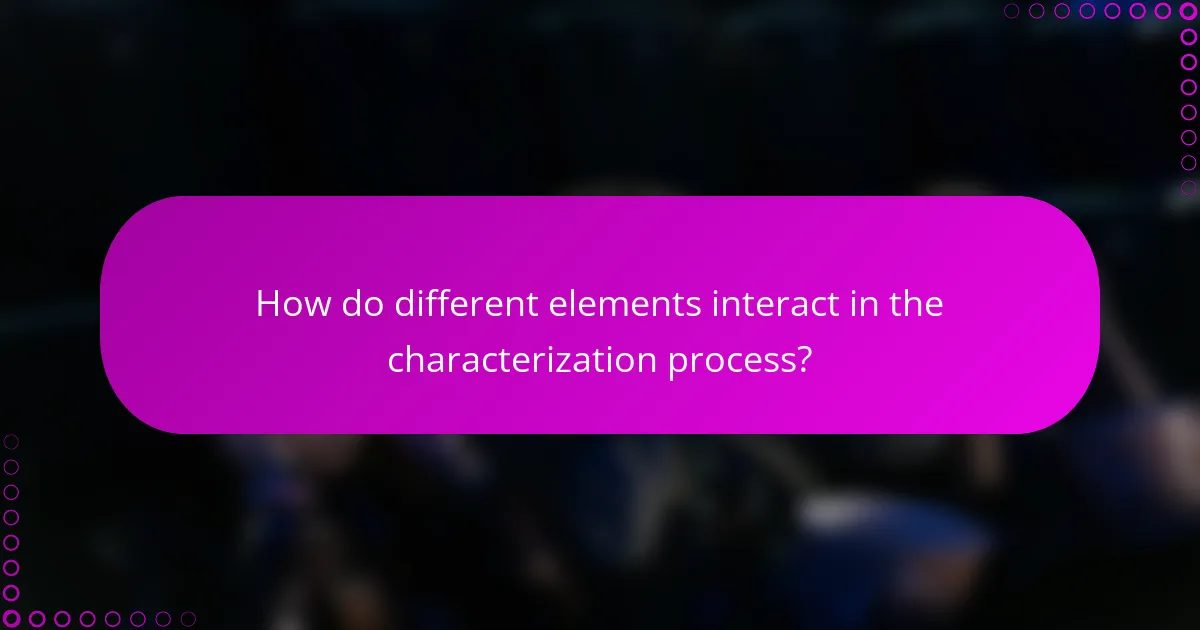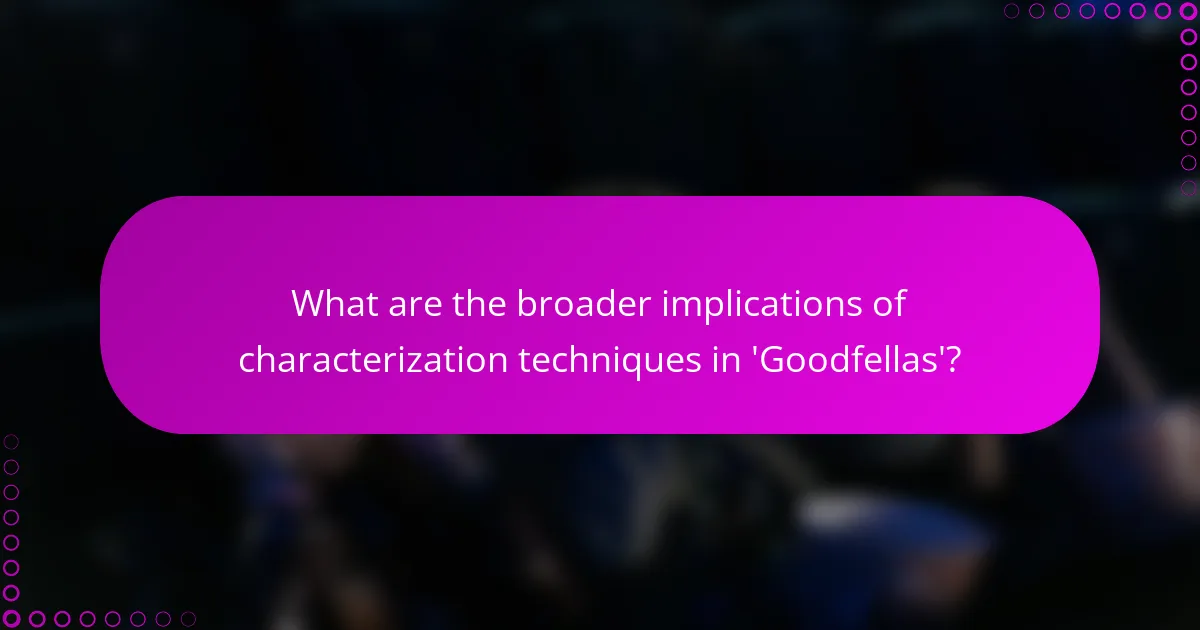The article examines characterization techniques in the film ‘Goodfellas,’ focusing on dialogue, performance, and character development. Key elements such as realistic dialogue reveal characters’ motivations and relationships, while performances by actors like Ray Liotta and Joe Pesci enhance emotional engagement and authenticity. The narrative structure, including voice-over narration, provides context that shapes character evolution and moral dilemmas. These techniques collectively contribute to the film’s critical acclaim and its status as a significant example of character-driven storytelling in cinema.

What are Characterization Techniques in ‘Goodfellas’?
Characterization techniques in ‘Goodfellas’ include dialogue, performance, and character development. Dialogue reveals characters’ personalities and motivations through their interactions. The use of voiceover narration gives insight into Henry Hill’s thoughts and feelings. Performances by actors convey emotional depth and authenticity. For instance, Ray Liotta’s portrayal of Henry showcases his transformation from a young gangster to a seasoned criminal. Character development is evident as characters evolve through their experiences and choices. The film’s pacing and editing enhance the portrayal of characters’ lives and relationships. These techniques create a rich, immersive narrative that captures the essence of the gangster lifestyle.
How does dialogue contribute to characterization in ‘Goodfellas’?
Dialogue in ‘Goodfellas’ significantly contributes to characterization by revealing the personalities and motivations of the characters. The way characters speak reflects their social status and emotional state. For instance, Henry Hill’s use of casual, streetwise language showcases his connection to the mob lifestyle. Additionally, dialogue often includes anecdotes that provide backstory, enhancing the viewer’s understanding of each character’s history and choices.
Characters like Jimmy Conway use terse, commanding speech to convey authority and intimidation. This sharp contrast in dialogue styles helps to distinguish between characters and their roles within the crime hierarchy. Furthermore, the use of idiomatic expressions and cultural references grounds the characters in their Italian-American identity.
Overall, the dialogue in ‘Goodfellas’ serves as a vital tool for character development, allowing the audience to grasp the complexities of mob life and the individuals within it.
What specific dialogue techniques are used to reveal character traits?
Dialogue techniques used to reveal character traits include subtext, tone, and word choice. Subtext allows characters to convey hidden feelings or intentions. For example, a character may say one thing while implying another, revealing deeper motivations. Tone conveys emotions and attitudes, showing how a character feels about a situation. A sarcastic tone can indicate disdain or humor. Word choice reflects a character’s background and personality. A character using formal language may suggest education or social status. These techniques collectively enhance characterization, making characters more relatable and complex.
How does the use of slang and vernacular enhance character authenticity?
The use of slang and vernacular enhances character authenticity by reflecting real-life speech patterns. Characters that use slang create a relatable and believable portrayal. This linguistic choice grounds characters in their cultural and social contexts. For example, in ‘Goodfellas’, the characters’ dialogue includes specific terms from Italian-American culture. This use of language captures their identity and background. Studies show that authentic dialogue increases viewer immersion and connection. Realistic language choices help audiences understand character motivations and relationships. Overall, slang and vernacular are crucial for creating genuine character experiences.
In what ways does performance shape character development in ‘Goodfellas’?
Performance in ‘Goodfellas’ significantly shapes character development through nuanced acting and emotional depth. Actors like Ray Liotta and Joe Pesci deliver powerful performances that embody their characters’ complexities. Liotta’s portrayal of Henry Hill showcases a transformation from innocence to criminality. This shift is evident in his changing demeanor and emotional responses throughout the film. Pesci’s performance as Tommy DeVito highlights volatility and aggression, influencing the audience’s perception of his character. The use of body language and [censured] expressions further communicates internal struggles and motivations. Additionally, the ensemble cast’s chemistry enhances character dynamics, illustrating relationships and conflicts effectively. Overall, performance serves as a critical vehicle for exploring the psychological and moral dimensions of the characters in ‘Goodfellas’.
What role does actor interpretation play in character portrayal?
Actor interpretation is crucial in character portrayal as it shapes how audiences perceive a character’s motivations and emotions. Through choices in voice, body language, and emotional delivery, actors bring depth to their roles. This interpretation can highlight a character’s complexities or flaws. For instance, in ‘Goodfellas’, actors like Ray Liotta and Joe Pesci used nuanced performances to convey the psychological intricacies of their characters. Research indicates that actor interpretation significantly influences audience empathy and understanding. This connection enhances the storytelling experience, making characters more relatable and memorable.
How do physical gestures and expressions contribute to character understanding?
Physical gestures and expressions significantly enhance character understanding. They convey emotions and intentions that words may not fully express. For example, a character’s clenched fists can indicate anger or frustration. Similarly, a relaxed posture may suggest confidence or ease. Research shows that nonverbal communication accounts for a large portion of interpersonal interactions. In “Goodfellas,” characters’ physicality reveals their psychological states. The way characters move or react in scenes provides insight into their motivations. This combination of gestures and expressions creates a richer understanding of character dynamics.
What is the significance of character development throughout the film?
Character development is significant in films as it drives the narrative and engages the audience. In ‘Goodfellas’, character arcs reflect the moral complexities of the characters involved in organized crime. As characters evolve, their motivations and consequences become clearer. This development allows viewers to understand the impact of their choices. For instance, Henry Hill’s transformation illustrates the allure and eventual disillusionment of the gangster lifestyle. The film’s narrative structure emphasizes these changes, showcasing the characters’ rise and fall. This approach enhances the emotional depth and realism of the story. Ultimately, character development serves as a critical mechanism for thematic exploration in ‘Goodfellas’.
How do characters evolve over the course of ‘Goodfellas’?
Characters in ‘Goodfellas’ evolve significantly throughout the film. Henry Hill transitions from an ambitious young mobster to a disillusioned informant. His initial excitement about the mob lifestyle shifts to fear and paranoia as law enforcement closes in on him. Jimmy Conway, portrayed as a charismatic leader, reveals a ruthless side as he prioritizes self-preservation over loyalty. Tommy DeVito embodies volatility, showcasing a descent into violence that ultimately leads to his demise. Karen Hill, initially enamored with Henry’s lifestyle, grows increasingly aware of the dangers and instability it brings. This evolution reflects the consequences of their choices and the moral complexities within organized crime. The film’s narrative structure and character arcs illustrate the harsh realities of mob life, emphasizing themes of loyalty, betrayal, and the quest for power.
What key events trigger character transformations?
Key events that trigger character transformations include significant life experiences, moral dilemmas, and pivotal relationships. In ‘Goodfellas’, characters undergo transformations due to events such as betrayal, violence, and the consequences of their choices. For instance, Henry Hill’s transition from a young mobster to a witness is driven by his increasing disillusionment with mob life. The impact of these events shapes their identities and moral compasses. Transformations are often marked by moments of crisis or revelation. These key events serve as catalysts for growth or decline, illustrating the complexity of character development.

How do different elements interact in the characterization process?
Different elements interact in the characterization process through dialogue, performance, and narrative development. Dialogue reveals characters’ motivations, emotions, and relationships. Performance adds depth through actors’ choices in expression and body language. Narrative development provides context and backstory, shaping how characters evolve. Together, these elements create a cohesive understanding of each character’s role. For instance, in “Goodfellas,” dialogue showcases the characters’ personalities and social dynamics. Performance enhances these traits through nuanced delivery. The narrative structure further informs the audience about characters’ pasts and futures. This interplay ensures a rich characterization experience.
What is the relationship between dialogue and performance in character portrayal?
Dialogue is essential for performance in character portrayal. It serves as a primary means of expressing a character’s thoughts, emotions, and intentions. The way characters speak influences audience perception and engagement. For example, in ‘Goodfellas’, the dialogue reflects the characters’ backgrounds and personalities. Specific word choices and speech patterns enhance authenticity. Effective dialogue delivery enhances the emotional impact of a scene. Actors rely on dialogue to convey subtext and develop relationships. This interplay between dialogue and performance shapes the overall narrative and character depth.
How do actors use dialogue to inform their performances?
Actors use dialogue to inform their performances by conveying character emotions and intentions. Dialogue provides essential context and background for the character’s motivations. It helps actors understand their character’s relationships with others. The choice of words reveals the character’s social status and personality traits. Actors analyze the rhythm and tone of dialogue to enhance delivery. This analysis allows for more authentic interactions in scenes. In ‘Goodfellas’, dialogue reflects the characters’ complex dynamics and cultural backgrounds. The film’s script serves as a blueprint for actors to embody their roles effectively.
What examples illustrate the synergy between dialogue and performance?
In ‘Goodfellas’, the synergy between dialogue and performance is exemplified through character interactions. For instance, Henry Hill’s narration complements his on-screen actions, creating a deeper understanding of his motivations. The use of rapid-fire dialogue during the “Funny how?” scene showcases the tension between characters, heightening the emotional stakes. Additionally, the scene in which Karen Hill confronts Henry about his infidelity uses dialogue to reveal their complex relationship dynamics. Each character’s delivery enhances the narrative, making the dialogue feel authentic and impactful. These examples demonstrate how dialogue and performance work together to enrich storytelling in the film.
How does the film’s narrative structure influence character development?
The film’s narrative structure significantly influences character development by shaping the audience’s perception of characters over time. ‘Goodfellas’ employs a chronological narrative interspersed with flashbacks. This structure allows for a gradual revelation of characters’ motivations and complexities. As the story unfolds, viewers gain insights into characters’ backgrounds and choices. The use of voiceover narration further deepens character understanding. It provides internal monologues that reveal thoughts and feelings. This technique creates a more intimate connection between the audience and the characters. Additionally, the pacing of the narrative affects character arcs. Fast-paced scenes highlight impulsive behavior, while slower moments allow for reflection. Overall, the narrative structure is crucial in enhancing the depth and relatability of characters in ‘Goodfellas’.
What narrative techniques are employed to enhance characterization?
Narrative techniques employed to enhance characterization include dialogue, performance, and inner monologue. Dialogue reveals character traits and relationships through their speech patterns and interactions. In ‘Goodfellas’, characters use specific language that reflects their backgrounds and social status. Performance, including body language and [censured] expressions, adds depth to characters beyond words. Actors convey emotions and motivations through non-verbal cues. Inner monologue provides insight into a character’s thoughts and feelings, allowing the audience to understand their internal conflicts. These techniques work together to create multi-dimensional characters, making them relatable and engaging.
How does the pacing of the story affect character arcs?
The pacing of a story significantly influences character arcs by dictating the timing and development of character transformations. Faster pacing can lead to rapid changes in characters, often compressing their growth into a short timeframe. This can create a sense of urgency and heighten emotional stakes. Conversely, slower pacing allows for more nuanced character development. It provides space for characters to evolve gradually, fostering deeper connections with the audience. In ‘Goodfellas,’ the pacing reflects the characters’ moral descent, with quick shifts mirroring their escalating conflicts and eventual consequences. This relationship between pacing and character arcs is crucial for maintaining narrative tension and audience engagement.

What are the broader implications of characterization techniques in ‘Goodfellas’?
Characterization techniques in ‘Goodfellas’ significantly impact audience perception and narrative depth. The film employs realistic dialogue to create authentic character interactions. This technique immerses viewers in the mobster lifestyle. Performance by actors like Ray Liotta and Joe Pesci enhances emotional engagement. Their portrayals provide insight into complex personalities and moral dilemmas. Character development reveals the consequences of crime and loyalty. The film’s structure, using voice-over narration, offers personal reflections that deepen understanding. These techniques contribute to the film’s critical acclaim and cultural relevance. ‘Goodfellas’ serves as a template for character-driven storytelling in cinema.
How do these techniques reflect the themes of the film?
The characterization techniques in ‘Goodfellas’ reflect the film’s themes of loyalty, betrayal, and the allure of crime. The use of sharp, realistic dialogue showcases the authenticity of mob life. It emphasizes the code of loyalty among characters, reinforcing the theme of camaraderie. Performances by the cast convey emotional depth, illustrating the personal costs of criminality. The character development throughout the film highlights the transformation from ambition to downfall. This progression mirrors the theme of moral decay inherent in the pursuit of power. The visual techniques, such as tracking shots, enhance the immersive experience of the criminal underworld. These elements collectively underscore the complex interplay between aspiration and consequence in the narrative.
What themes are highlighted through character interactions and development?
Character interactions and development in ‘Goodfellas’ highlight themes of loyalty, betrayal, and the pursuit of power. Loyalty is emphasized through the close-knit relationships among characters, showcasing their commitment to each other. Betrayal emerges as a significant theme when characters turn against one another, illustrating the fragility of trust. The pursuit of power is evident in the characters’ ambitions and actions, driving the narrative forward. These themes are reinforced by the film’s dialogue and character arcs, reflecting the complexities of their relationships. The consequences of these interactions ultimately shape the characters’ fates, underscoring the impact of their choices.
How do characterization techniques contribute to the film’s overall message?
Characterization techniques in ‘Goodfellas’ significantly enhance the film’s overall message about the allure and consequences of mob life. Through dialogue, characters reveal their motivations and moral complexities. Performance by actors conveys emotional depth, making the audience empathize with their choices. Development of characters illustrates their transformation over time, showcasing the impact of crime on personal relationships. For example, Henry Hill’s descent into the criminal underworld demonstrates the seductive nature of power and wealth. Additionally, the film juxtaposes the glamour of mob life with its brutal realities. These techniques collectively reinforce the theme that crime ultimately leads to isolation and despair.
What can filmmakers learn from the characterization techniques in ‘Goodfellas’?
Filmmakers can learn the importance of authenticity in characterization from ‘Goodfellas’. The film employs realistic dialogue that reflects true mob culture. This authenticity enhances character development and audience connection. Another technique is the use of voiceover narration. It provides insight into characters’ thoughts and motivations. This technique allows for deeper emotional engagement. Additionally, the film showcases how relationships shape characters. The dynamics between characters reveal their complexities. Overall, ‘Goodfellas’ demonstrates that nuanced characterization can elevate storytelling.
What best practices can be applied to enhance character portrayal in films?
To enhance character portrayal in films, filmmakers should focus on developing rich backstories for characters. Backstories provide context and depth, making characters more relatable. Additionally, utilizing strong dialogue is crucial. Dialogue should reveal personality traits and motivations, allowing audiences to connect with characters.
Actors must also be encouraged to immerse themselves in their roles. This immersion leads to authentic performances that resonate with viewers. Furthermore, visual storytelling techniques should complement character development. Cinematic elements like lighting and framing can emphasize emotional states and character arcs.
Incorporating feedback from test screenings can refine character portrayals. Audience reactions can highlight which aspects resonate or fall flat. Lastly, collaborating with experienced writers and directors ensures a cohesive vision for character development. These practices collectively enhance the authenticity and impact of characters in films.
How can emerging filmmakers utilize these techniques in their own work?
Emerging filmmakers can utilize characterization techniques from ‘Goodfellas’ by focusing on authentic dialogue and nuanced performances. They should analyze how the film employs realistic conversations to build character depth. Filmmakers can adopt similar writing styles to create relatable and believable characters.
Performance is crucial; actors should be encouraged to embody their roles fully. This can lead to more engaging on-screen chemistry. Additionally, filmmakers can study character development arcs in ‘Goodfellas’ to understand how to evolve characters throughout the narrative.
Using these techniques can enhance storytelling and audience connection. The effectiveness of these methods is evident in the film’s critical acclaim and lasting impact on cinema.
The main entity of the article is the characterization techniques used in the film ‘Goodfellas’. The article provides an in-depth analysis of how dialogue, performance, and character development contribute to the portrayal of characters in the film. It examines the significance of dialogue in revealing character traits and motivations, the impact of actor performances on character depth, and the evolution of characters throughout the narrative. Additionally, it discusses the interplay between these elements and their broader implications for understanding themes such as loyalty, betrayal, and the consequences of crime. Overall, the article highlights the importance of nuanced characterization in enhancing storytelling and audience engagement.


